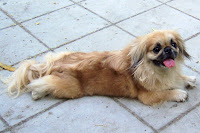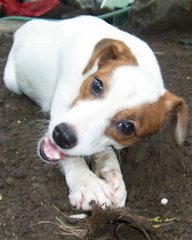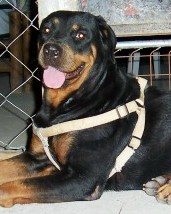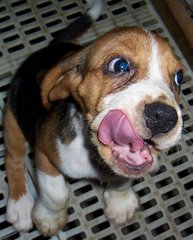Monday, December 31, 2007
Tuesday, November 06, 2007
Save the cheerleader, save the dolphins
 Fourteen thousand dolphins are killed in Japan every year. The manner of killing is barbaric. I learned about this sad fact, because Hayden Panettiere went to Japan to try to save a group of pilot whales from slaughter. msnbc wrote "As a spokesperson for SaveTheWhalesAgain.org, Panettiere hopes her traumatic ordeal will help raise awareness. 'We all crossed our fingers that those whales didn’t die in vain,' she concluded."
Fourteen thousand dolphins are killed in Japan every year. The manner of killing is barbaric. I learned about this sad fact, because Hayden Panettiere went to Japan to try to save a group of pilot whales from slaughter. msnbc wrote "As a spokesperson for SaveTheWhalesAgain.org, Panettiere hopes her traumatic ordeal will help raise awareness. 'We all crossed our fingers that those whales didn’t die in vain,' she concluded."While it is not fair to condemn an entire country or a condemn an entire people for the actions of a few, or even the actions of the majority, the rational mind has it limits, and 14,000 Dolphins is past mine. I do condemn.
"Whales and dolphins are traditionally used (as resources) in Japan," said Hideki Moronuki of the Japanese Fisheries Agency. "In this light, we cannot accept an argument simply based on emotional causes."
I am angry, and angry people are not rational ones. I just lost my taste for anything Japanese, their cars, their foods, their clothes... everything with "Made in Japan" stamped on it. I will do my best, to give Ms. Moronuki, more than "emotional causes" to change her mind.
Next time someone ask me to eat at a Japanese Restaurant, I will just have to say, "I am sorry I do not eat Japanese food. They kill dolphins." Besides, all the blood killed my appetite.
Photo from SaveTheWhalesAgain.org
Saturday, November 03, 2007
Dog Biscuits
 It is no secret that our dogs go gaga over dog biscuits. Recently, we got them this big bag of gourmet flavor dog biscuits and they tore into it in just a few days. One morning I saw Maguai sleeping soundly on top of the empty package of the biscuits. Apparently, it fell into his cage the night before. I can only imagine what he was dreaming about that morning.
It is no secret that our dogs go gaga over dog biscuits. Recently, we got them this big bag of gourmet flavor dog biscuits and they tore into it in just a few days. One morning I saw Maguai sleeping soundly on top of the empty package of the biscuits. Apparently, it fell into his cage the night before. I can only imagine what he was dreaming about that morning.I used to make huge batches of homemade dog biscuits for our little furry friends. But lately, I'd been very busy with work and whatnot that I could not bake for them anymore. Soon, I hope. I know that dog bone cookie cutter is stashed up there somewhere. Making these dog biscuits is pretty enjoyable after all, I can use the R&R. And watching these cute little dogs happily gobble up what you make is the icing on the cake.
Friday, July 06, 2007
Thursday, June 28, 2007
Gourmet Flavor Dog Biscuits
 I found this HUGE bag of dog biscuits in the supermarket a few days ago. The bag was huge and screaming purple so it was really hard to miss. I looked closer. 8 pounds of imported dog biscuits for only Php 462.50! Of course, I had to get one.
I found this HUGE bag of dog biscuits in the supermarket a few days ago. The bag was huge and screaming purple so it was really hard to miss. I looked closer. 8 pounds of imported dog biscuits for only Php 462.50! Of course, I had to get one. The biscuits come in 5 gourmet flavors- chicken, bacon, peanut butter, vegetable, and beef. They smell so good that I am tempted to try one. But I have a feeling that our dogs won't agree if I took one. They get very excited when they see me approaching their kennel with handfuls of these biscuits. Needless to say, these dog biscuits are a hit.
The biscuits come in 5 gourmet flavors- chicken, bacon, peanut butter, vegetable, and beef. They smell so good that I am tempted to try one. But I have a feeling that our dogs won't agree if I took one. They get very excited when they see me approaching their kennel with handfuls of these biscuits. Needless to say, these dog biscuits are a hit.Tuesday, June 19, 2007
The Buff -Dog
 Buffy
Buffy Close-up
Close-up When not walking, Buffy maintains this stance as she is ready to bolt
When not walking, Buffy maintains this stance as she is ready to bolt When walking or loitering around she keeps her nose to the ground a lot,
When walking or loitering around she keeps her nose to the ground a lot,displaying her hunting dog heritage
 And she is always alert, reacting to anything that goes on around her... well unless she is single-mindedly chasing a chicken or something.
And she is always alert, reacting to anything that goes on around her... well unless she is single-mindedly chasing a chicken or something.Monday, June 18, 2007
Recycled puppies
Thursday, June 14, 2007
Oxyfresh: Found!
 Last Friday, June 8, 2007, Robin and I went on a little trip to Tagaytay. We had lunch at Breakfast at Antonio's and on our way home, we noticed some signs of dog supplies manufacturers outside Tagaytay Vista Hotel. Curious, we stopped by to have a look-see. As it turns out, the Veterinary Practitioners Association of the Philippines (VPAP) is holding its 35th Annual Scientific Conference. Outside the venue, there were a lot of stalls showcasing veterinary products.
Last Friday, June 8, 2007, Robin and I went on a little trip to Tagaytay. We had lunch at Breakfast at Antonio's and on our way home, we noticed some signs of dog supplies manufacturers outside Tagaytay Vista Hotel. Curious, we stopped by to have a look-see. As it turns out, the Veterinary Practitioners Association of the Philippines (VPAP) is holding its 35th Annual Scientific Conference. Outside the venue, there were a lot of stalls showcasing veterinary products.We spied on an Oxyfresh banner outside so we were quite hopeful to find them in one of the stalls. We have been looking for Oxyfresh for over a year now after their office in Mandaluyong closed down. That is why I was very happy when I found out that they did have a stall there. I was able to talk to Liza, Oxyfresh's Direct Marketing Coordinator and I told her how glad we were to find them. Their pet deodorizer worked really well on our Pekingese dogs which are quite infamous for bad breath (tee hee..).
MAKATI OFFICE
Suite 910 Medical Plaza, Amorsolo cor. Dela Rosa, Legazpi Village, Makati City
QUEZON CITY OFFICE
Suite 811 Future Point Plaza, 112 Panay Avenue, Quezon City
Tuesday, May 29, 2007
Bath Time!
 Marcia and Chiqui shaking off the excess water from their fur.
Marcia and Chiqui shaking off the excess water from their fur. It's Chico's turn for a bath.
It's Chico's turn for a bath.Much to the envy of the beagles.
Tuesday, May 15, 2007
Pekingese photo shoot
Sunday, May 13, 2007
Dog day at Tagaytay

Started out in Tereyaki Boy where Buffy and I shared a Sukiyaki. Buffy was generally well behaved, although she did jump one waiter (on those occasions I am really glad she is a small dog) and later tip over her water bottle to Kristine's consternation. We then went to Picnic Grove where we met up with Leen. Were threated to another nice view of the Taal Volcano. After Picnic Grove, we went to Bag of Beans where Buffy and I shared in the Apple Pie and Braided Bread. Surprisingly, she loved both. Ended day at Josephine's again overlooking the Taal Volcano.
Tuesday, May 08, 2007
It is a very hot summer!

Meet Jaja a resident of the Anahaw Island View Resort
Wednesday, April 18, 2007
Magi at High Street
Monday, April 16, 2007
Dog Biscuit Recipe
 | 2 teaspoons dry yeast 1/2 cup lukewarm water 2 tablespoons dry parsley | 1 1/2 cups chicken broth 3 tablespoons honey 1 egg 5-6 cups whole wheat flour |
Directions:
Preheat oven to 350 ° F (180 ° C).In a large bowl, dissolve yeast in warm water. Stir in the parsley, broth, honey, and egg. Gradually blend in flour, adding enough to form a stiff dough.
Transfer to a floured surface and knead until smooth (about 3-5 minutes). Shape the dough into a ball, and roll to 1/4-inch (6 mm) thick. Using small bone-shaped cookie cutters, make biscuits! Transfer to ungreased baking sheets, spacing them about 1/4 inch (6 mm) apart. Gather up the scraps, roll out again, and cut additional biscuits.
Bake for 30 minutes. Remove from oven and turn over. Bake for an additional 15 minutes, or until lightly browned on both sides. Let cool overnight. (After we finish baking all batches of biscuits, we turn off the oven, then spread all the biscuits out on one baking sheet and set them in the oven to cool overnight. The extra time in the oven as it cools off helps make the treats crispier and crunchier.)
Makes several dozen small bones that keep and freeze well. We like these biscuits because they're quick and easy and we always have the ingredients on hand to make them. Our boys like them because they're good!
We make our own chicken broth by boiling 1 pound of chicken in 8 cups of water, seasoned with 1 teaspoon thyme, 3 teaspoons parsley, 1 teaspoon celery seed, and one bay leaf, for 1 1/2 hours. Remove the chicken and use it for salads or other recipes that call for cooked chicken. Let the broth cool before using it in these recipes.
Monday, April 09, 2007
Stud Service: Pekingese
Saturday, April 07, 2007
Mushu
Friday, April 06, 2007
Thursday, April 05, 2007
Wednesday, April 04, 2007
Snow White Pekes for Sale
 This ad was posted in dogtracker.com on March 23, 2007. Php26k for the female and Php16500 for the male. Click here for more info.
This ad was posted in dogtracker.com on March 23, 2007. Php26k for the female and Php16500 for the male. Click here for more info.Wednesday, March 21, 2007
Pet food Recall
WASHINGTON - A massive pet food recall has touched a nerve with pet-loving Americans, many of whom see their pets as family members.
The recalled products — 60 million cans and pouches of wet dog and cat food manufactured by Menu Foods of Ontario, Canada — account for 1 percent of pet food sold in the United States, the Food and Drug Administration has said. But in a country where more than half the people in a 2004 survey said they would risk their lives for their pets, the thought that food could kill their animals sent fearful consumers scrambling for information about affected products.
You can read the rest of the report here. Am a bit worried about what I feed my little Buffdog. Will see what else I can find and posts updates.Update: I found a website where you can find a list of recalled products: Recalled Dog Product Information. Looks like it only covers wet foods for dogs and cats.
Saturday, March 17, 2007
Ehrlichiosis
Ehrlichiosis is caused by the rickettsial organism Ehrlichia canis. Other examples of rickettsial organisms are Riskettsia rickettsi, which causes Rocky Mountain Spotted Fever and Ehrlichia risticii, which causes Potomac Fever in horses. These orgainisms tend to be carried by ticks and other insect vectors, in some cases. For ehrlichiosis, the most common vector is the brown dog tick. For this reason, ehrlichiosis occurs anywhere this tick occurs. At present, it has been reported in 34 states, with the northern states being spared in most instances. The southeastern and south central states are the most heavily affected. A few cases of Ehrlichia canis infection have been reported in people after tick bites.
Ehrlichia infection can cause a number of clinical signs. It can be extremely hard to diagnose due to the wide range of symptoms that can occur. Most dogs infected with this organism will have be lethargic, lose weight, show less interest in food and become anemic. Other possible clinical signs include hemorrhages under the skin or in around the gums, swollen lymph nodes, muscular or joint soreness, nasal discharges or nosebleeds, severe neck or back pain, blood in the urine and eye problems ranging from exudates to severe inflammation of the internal eye structures. Neurologic signs such as seizures and difficulty walking can occur. Respiratory or heart related signs can occur due to hemorrhaging and compensation for anemia if it becomes severe. Hemorrhaging occurs primarly due to decrease in platelet counts from the infection. While most dogs show a number of symptoms when first infected with Ehrlichia, there is also a chronic infection that can occur if the acute infection is not treated. In this case, the dog may appear to be normal or may show vague signs of illness occasionally. This is one cause of the complaint that "my dog just isn't doing right". The chronic illness can suddenly become very severe again if the dog is stressed in some manner or become less immune competent for some reason.
The best method of diagnosing this disease is through testing of serum from the dog using an immunofluorescent antibody (IFA) test. Unfortunately, a positive test only indicates exposure. Still, in the presence of clinical signs or if the titer rises after treatment or stays consistently high, infection is strongly implied by the lab results.
Ehrlichia canis is normally susceptible to treatment with tetracycline antibiotics, including doxycycline. In some situations the organism will not respond to these antibiotics or their use is contraindicated due to the young age of a dog or pregnancy. In this case, chloramphenicol can be used and there is anecdotal evidence of success using cephalosporin antibiotics. The bleeding tendencies in this disease are related to a drop in platelets (thrombocytopenia) so it can be necessary to use corticosteroids to treat this condition if the platelet counts are low. While this can be life saving, the use of corticosteroids should be discontinued as quickly as possible so that their immunosuppressive effect does not interfere with successful treatment. Extensive supportive care, including intravenous fluids, administration of blood products and hospitalization may be necessary to treat this problem in some dogs. The survival rate is good if the disease is recognized and treated aggressively.
Other articles on this disease:
http://www.rwba.org.za/info/Ehrlichiosis.htm
http://www.vet.uga.edu/VPP/clerk/Bockino/
http://frontline.us.merial.com/news/news_101804.asp
Friday, March 16, 2007
Switching Dogfood
 Taking the cue from Buffy the JRT who obviously loves this food, we are switching all our dogs to Eukanuba lamb and rice dog food.
Taking the cue from Buffy the JRT who obviously loves this food, we are switching all our dogs to Eukanuba lamb and rice dog food.So far so good.
Friday, March 02, 2007
Leptospirosis
Symptoms
| In acute infections, a fever of 103-104°, shivering, and muscle tenderness are the first signs. |
In acute infections a fever of 103-104°, shivering, and muscle tenderness are the first signs. Then vomiting and rapid dehydration may develop. Severely infected dogs may develop hypothermia and become depressed and die before kidney or liver failure has a chance to develop.
In subacute infections, the animal usually develops a fever, anorexia, vomiting, dehydration, and increased thirst. The dog may be reluctant to move due to muscle or kidney pain. Animals with liver involvement may develop icterus. Dogs that develop kidney or liver involvement may begin to show improvement in organ function after 2 to 3 weeks or they may develop chronic renal failure. Despite the possibility of severe infection and death, the majority of leptospiral infections in dogs are chronic or subclinical. Dogs that become chronically infected may show no outward signs, but may intermittently shed bacteria in the urine for months or years.
Diagnosis
A positive diagnosis can be made through a blood test. A blood sample of the suspected animal is drawn and sent into the laboratory where a microscopic agglutination test is performed. This can test for individual serovars (strains) and the level of antibody (titer) against these strains. Depending on the level of the titer, a positive diagnosis to the specific serovar can be made. Titers may be negative in the first 10 days after initial infection, so many times additional samples must be drawn and tested to get a positive diagnosis. Previous vaccination can give an elevated titer and this must be taken into consideration when interpreting the titers.
Acutely infected or chronically infected dogs will most likely be shedding Leptospira organisms in their urine. It is possible to culture a urine sample and get a positive diagnosis. However, because of intermittent shedding and bacterial contamination this is not always the best way to diagnose the disease.
Treatment
Treatment consists of antibiotics, fluid replacement, and controlling the vomiting and the problems associated with the corresponding kidney or liver infections. Penicillin, or one of its derivatives is the antibiotic of choice for treating the initial infection. After the initial infection is controlled, doxycycline is often used to cure and prevent a potential long-term carrier state. Intravenous or subcutaneous fluids are often given to correct dehydration while the corresponding liver or kidney problems are treated.
Read the rest of the article HERE.
Sunday, February 25, 2007
Kennel Cough
 WHAT IS IT?
WHAT IS IT?
Kennel cough is a bronchitis characterized by a harsh, hacking cough which most people describe as sounding like “something stuck in my dog’s throat.” It is analogous to a chest cold for humans and is only a serious condition in special circumstances (see below); in general, it resolves on its own..
HOW INFECTION OCCURS?
 The normal respiratory tract has substantial safeguards against invading infectious agents. The most important of these is probably what is called the “mucociliary escalator.” This safeguard consists of tiny hairlike structures called cilia, which protrude from the cells lining the respiratory tract, and a coat of mucus over them. The cilia beat in a coordinated fashion. Debris, including infectious agents, get trapped in the sticky mucus and the cilia move the mucus upward towards the throat where the collection of debris and mucus may be coughed up and/or swallowed.
The normal respiratory tract has substantial safeguards against invading infectious agents. The most important of these is probably what is called the “mucociliary escalator.” This safeguard consists of tiny hairlike structures called cilia, which protrude from the cells lining the respiratory tract, and a coat of mucus over them. The cilia beat in a coordinated fashion. Debris, including infectious agents, get trapped in the sticky mucus and the cilia move the mucus upward towards the throat where the collection of debris and mucus may be coughed up and/or swallowed.
The mucociliary escalator is damaged by the following:
- shipping stress
- crowding stress
- heavy dust exposure
- cigarette smoke exposure
- infectious agents (viruses such as reovirus, adenovirus, parainfluenza virus, and even the distemper virus can be initiating infections)
- Cold temperature
- Poor ventilation
Without this protective mechanism, invading bacteria, especially Bordetella bronchiseptica may simply march down the airways unimpeded.
Bordetella bronchiseptica has some tricks of its own as well:
- It is able to bind directly to cilia, rendering them unable to move within 3 hours of contact.
- It secretes substances that disable the immune cells normally responsible for consuming & destroying bacteria
Because it is common for Bordetella to be accompanied by at least one other infections agent (such as one of the viruses listed above), “Kennel Cough” is actually a complex of infections, rather than infection by one agent.
Classically, dogs get infected when they are kept in a crowded situation with poor air circulation but lots of warm air (i.e. a boarding kennel, vaccination clinic, obedience class, local park, animal shelter, animal hospital waiting room, or grooming parlor). In reality, most causes of coughing that begin acutely in the dog are due to infectious causes and usually represent some form of Kennel Cough.
THE INCUBATION PERIOD IS 2 - 14 DAYS
HOW CONTAGIOUS IS IT?
Bordetella infection can be picked up by rabbits, guinea pigs, pigs, cats (if they are very young and housed in groups), and other dogs. It is not contagious to humans though it is closely related to Bordetella pertussis, the agent of Whooping Cough. Among dogs it is fairly contagious depending on stress level, vaccination status, and exposure to minor viruses.
Our hospital recommends keeping all dogs current on their Bordetella vaccinations as you never know when they be in an unexpected situation
HOW IS IT TREATED?
Although most cases will go away on their own, we like to think we can hasten recovery with antibiotics to directly kill the Bordetella organism. Alternatively, Kennel Cough may be treated with cough suppressants to provide comfort during natural recovery. Or antibiotics and cough suppressants can be combined.
WHEN IS IT A SERIOUS CONDITION?
In very young puppies, especially those with a recent shipping history (i.e. pet store puppies) are especially prone to severe cases of infectious tracheobronchitis (frequently progressing to pneumonia).
In dogs where the distemper virus is involved (usually shelter or pet store puppies), there is tremendous potential for serious consequences. (For more information on distemper, click here)
VACCINATION OPTIONS:
There are basically two options for Kennel cough vaccination: injectable and intranasal.
Injectable is a good choice for aggressive dogs, who may bite if their muzzle is approached. It provides good systemic immunity as long as two doses are given after age 4 months (with an annual booster). Injectable vaccination may only lead to less severe infection and not complete prevention.
Intranasal vaccination may be given as early as 2 weeks of age and immunity generally lasts 10-12 months. (Usually this vaccine is boosted annually.) The advantage here is that the local immunity is stimulated, right at the site where the natural infection would be trying to take hold.
It takes 4 days to generate a solid immune response after intranasal vaccination so it is best if vaccination is given at least 4 days prior to the exposure. Some dogs will have some sneezing or nasal discharge in the week following intranasal vaccination. As a general rule, nasal vaccination provides faster immunity than injectable vaccination.
Parainfluenza, Adenovirus type 2, and canine distemper, all members of the Kennel Cough complex, are all covered by the standard DHLPP vaccine, the basic vaccine for dogs. Adenovirus Type 2 serum also immunizes against Adenovirus Type 1, the agent of infectious canine hepatitis.
VACCINATION IS NOT USEFUL IN A DOG
ALREADY INCUBATING KENNEL COUGH
WHAT IF IT DOESN’T IMPROVE?
As previously noted, this infection is generally self-limiting. It should be at least improved partially after one week of treatment. If no improvement has been observed in this time, a re-check exam (possibly including radiographs of the chest) would be a good idea.SOURCE: www.maristavet.com
































